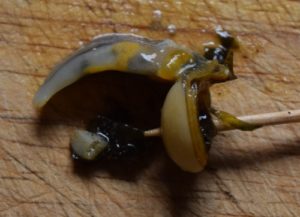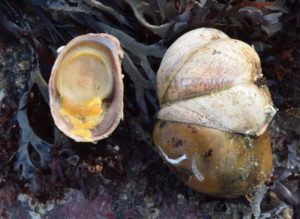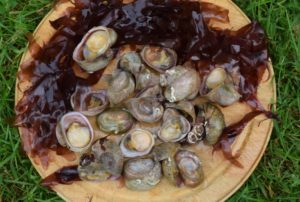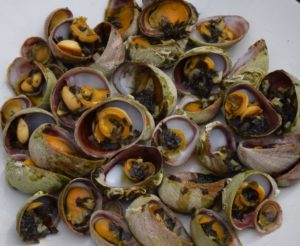23/04/2019
It is so often the case with wild food that responsible collecting behaviour requires you only to take what you need, and leave the rest for nature. Exactly the opposite is true is when the species you are after is an invasive alien, and in a few cases these invasive species are first class edibles. The perfect example is the Atlantic Slipper Limpet (Crepidula fornicata).
Slipper Limpets are native to the Atlantic coast of North America. They have been repeatedly introduced to northern Europe, the first record being in 1872 in Liverpool Bay. They are now very common along the entire southern coastline of Great Britain, from Pembrokeshire to The Wash. Where conditions are to their liking, their numbers can increase to plague proportions, and they cause serious problems for native filter-feeding marine molluscs, especially oysters. Slipper Limpets both out-compete the native species for food, and smother them in the fine silt they eject after feeding. In the worst cases, their presence has resulted in the total destruction of important oyster fisheries.
They are under-utilised as a food resource. There is apparently no commercially viable market for them, which causes fishermen problems, since it is illegal to return them to the water if they are dredged up as bycatch. It is not clear why this should be, since they are very tasty and highly regarded in as food in a few places. They are not tough like Common Limpets (Patella vulgata). They are in season from early autumn until early spring. It is best practice not to collect them for food during the summer, because as filter feeders there is a greater possibility that they have been consuming toxic algae. Now (late April) is a good time.
They can be found in sandy or muddy areas during low tides. They are easily recognised by their distinctive shell shape and their tendency to live in stacks. The creatures change sex during their lifetime. They start out male, with the smaller males attaching frequently themselves to the top of an existing stack. As they get larger, with more and more smaller individuals on top of them, they turn into females, so they are continually next to a mate (hence the specific epithet “fornicata”). These stacks are permanent – the slipper limpet’s shell grows to exactly fit whatever they are attached to, so after a while it becomes impossible for them to find anywhere else to attach to. Being dislodged is therefore fatal, since they are totally exposed to predation, which means you often find a detached stack where the bottom-most shell is empty.
More frequently the bottom limpet is attached to a large pebble, and this poses a challenge when collecting them. Since you do not want to end up having to carry a load of pebbles around, you need to separate the stack of limpets from the pebble, and this can only be done quickly. You need to creep up on them and grab the whole stack, then immediately rip the bottom limpet from the pebble. Within two or three seconds, if you have not succeeded in doing so, the limpet will clamp down and it becomes much more difficult.

A cocktail stick is sometimes required to extract the internal part of the slipper limpet, which easily breaks off of the foot.
When you’ve finished collecting, you should give them a good rinse in clear seawater. When you get your haul back home, wash them again in fresh water. You do not need to leave them sitting in salt water overnight as is recommended for some other marine molluscs (such as winkles). They can be eaten raw, but it to be 100% safe it is surely best to cook them. They only need brief cooking. I usually just boil them for two or three minutes.
They should be served with garlic butter, with a bit of salt and pepper (and not too much garlic). The perfect finishing touch, if it is available from the same beach, is some finely chopped Dulse (Palmaria palmata) in the garlic butter. This red seaweed adds a lovely umami taste which does not overpower the abalone-like taste of the slipper limpets.



